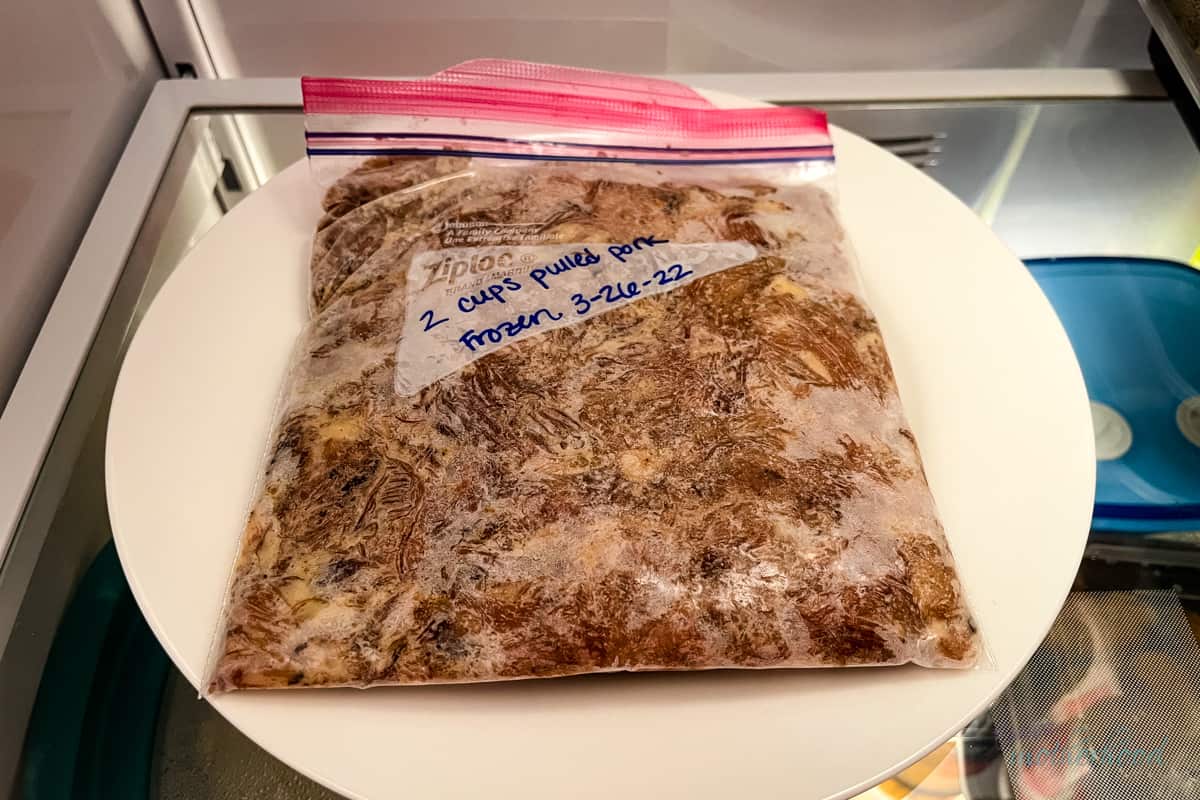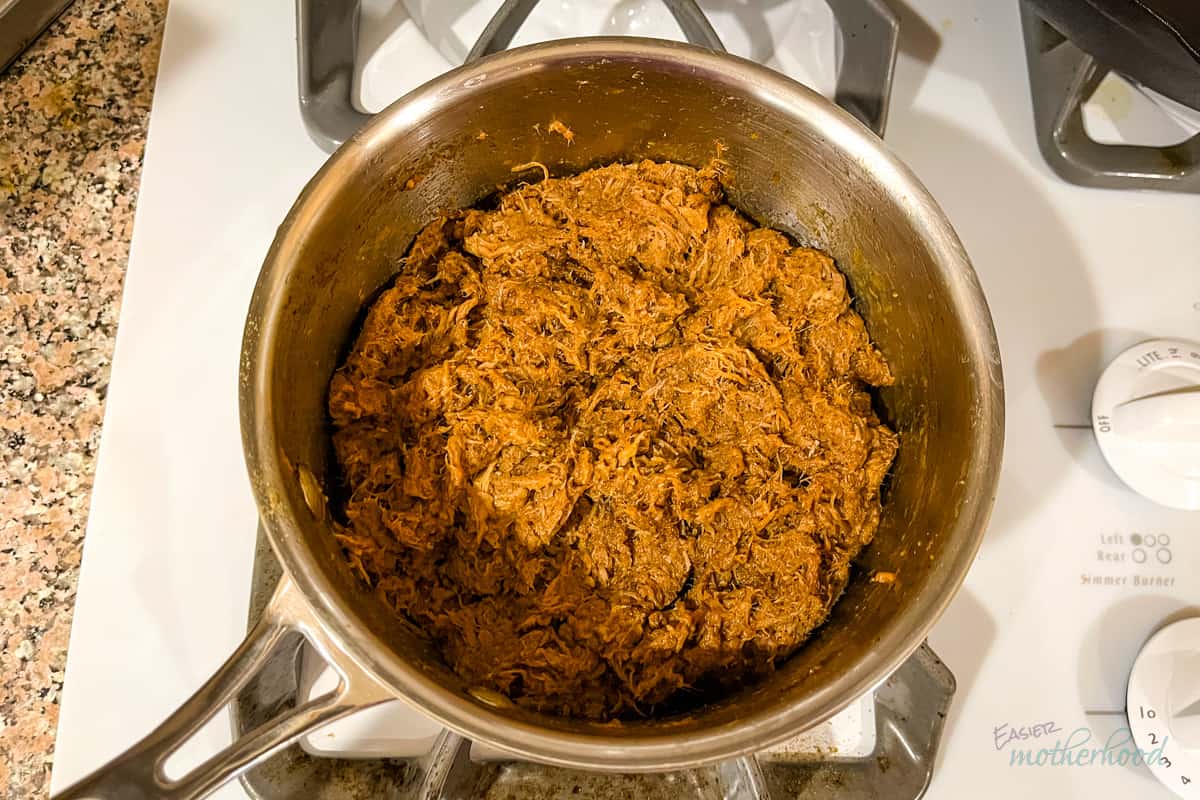Do you have too much leftover pulled pork to eat before it goes bad? I’ve got you covered. Well, me, some freezer bags, and a permanent marker have you covered.
Pork shoulder, also known as pork butt, pork rump roast, or boston butt roast, is a flavorful cut of meat that is also budget friendly. I often grab this type of meat when they’re on sale to prepare in my slow cooker.
It’s great when feeding a crowd, but because the cut naturally lends itself to large batches, if you’re not hosting a barbeque it’s also pretty likely you find yourself with leftovers. And one can only eat so many pulled pork sandwiches in the same week.
In this guide, we’ll review the proper steps to freezing pulled pork for the best results, so all your hard work making it doesn’t go to waste, and you can have cooked pork on hand for a sandwich or pork tacos.
Have leftover chicken instead? The methods are very similar, but I have a dedicated how-to for freezing rotisserie chicken here.
No time to read now? Pin it for later!

This post contains affiliate links, which means I receive a small commission, at no additional cost to you, if you make a purchase using this link.
Making Pulled Pork
There are a number of ways to make pulled pork- my preferred method uses the slow cooker, because it’s set it and forget it- and dump and go crock pot recipes are a lifesaver on busy days. Barbecue enthusiasts may prefer to smoke it, which is also delicious. The key with any pulled pork recipe is to make sure it cooks low and slow- that’s what turns it into tender meat that shreds easily. This results in the pork being a higher internal temperature than the minimum 145 recommended, which is necessary for shredding, and cooked slowly it will still be fall apart tender.
When making a big batch of pulled pork that you know will yield leftovers, I recommend staying away from barbecue sauce during the cooking process. A spice mix like the one used in this recipe keeps the flavor of the pork as the main focus, and makes the meat more adaptable to different cuisines for leftovers. You can of course still slather your sandwich with bbq sauce!
What can I make with leftover pulled pork?
There are loads of ways to turn leftover pork into another delicious meal! Some favorite ways include: tacos, taquitos, pork fried rice, rice bowls, burritos, nachos, empanadas, egg rolls, pot stickers, crescent sandwiches, pastas, sliders, salads, and yes, barbecue sandwiches.
Before Freezing
Allow your pulled pork to come to room temperature before freezing leftovers. You can store fresh pork leftovers in the refrigerator for 3-5 days in an airtight container, though I recommend freezing them by the 3 day mark.
To determine what size bag you’ll use, think about how much meat you’ll pull out of the freezer for a recipe. These leftover pulled pork carnitas tacos use 2 cups for 8 tacos. You may use less in a dish like pork fried rice or for individual portions, or more for a big family or hungry teenagers. While you can freeze pulled pork twice from a food safety perspective, it can negatively impact the flavor and increase the likelihood of freezer burn. So, it’s best to freeze in a couple of smaller bags rather than one large one.
For a small portion of 1 cup up to 3 cups of pulled pork, use a quart freezer top. For portions of 4 cups or more a gallon freezer bag is preferable.
Freezing Instructions
Once your pork is at room temperature- or below, if you refrigerated it- grab some quart freezer or gallon freezer bags, and a sharpie. Alternatively, you can use a vacuum sealer if you have one. A measuring cup is also handy to know exactly how much meat you place in each large resealable freezer bag.

The first step is to use your measuring cup to add one meal’s worth of meat to a ziploc bag. Be sure to include some of the cooking juices to keep it moist. Use your hands or a rolling pin to flatten it out, and as the meat starts to get near the seal, close it three quarters of the way.

Continue to work the meat into an even layer, pressing it into the corners and edges, and removing as much excess air out of the open portion as possible. Too much air can contribute to freezer burn.

Finish sealing the bag, and label it clearly with the quantity of meat, and the date of freezing. Place meat in your freezer flat while the pork freezes, after which you can place it upright or on its side if that is more convenient for you.

If you do not have freezer bags, you can use a freezer safe container and plastic wrap. Press the pork into the container as tightly as you can, then top with the cling wrap and press the air out from underneath it. Label the container and freeze.
Once frozen, cooked pulled pork should last in your freezer up to 3 months.
Defrosting Instructions
There are two primary methods of defrosting frozen pulled pork. The first and best way is to thaw it in the refrigerator. To do so, place a single bag on a rimmed plate or in a container and put it on a shelf in the fridge. The plate is in case the bag got punctured while in your freezer- you don’t want any leaks in your fridge. This method allows you to refreeze the pork if your plans change without food safety concerns, though going through the freezing process multiple times does increase the risk of freezer burn and negatively impacts the quality of the meat.

The second way is to defrost the pork in cold water. This is a faster method than the refrigerator and maintains good quality pork. However, because the temperature change is relatively quick, it is not recommended to refreeze meat that has been thawed with this method. Cold water should be changed out every 30 minutes to avoid bacterial growth.
A third but less common method is sous vide, a cooking method that can also be used to both defrost and reheat. While typical zip-top bags are not meant for microwaving or boiling, Anova endorses them for sous vide cooking. To use the sous vide method, submerge your bag of frozen pulled pork in a pot of water and set your sous vide appliance to 145 degrees until the pork is hot and ready to serve.
Reheating Instructions
For best quality, reheat your pulled pork on the stove top. Place the meat in a pan or pot along with a few tablespoons of water, and warm over medium heat until it reaches the correct temperature of at least 145 degrees.

You can also reheat in a conventional oven. Preheat your oven to 225 and place your pork in a casserole dish, roasting pan, or oven safe pot. Cover with aluminum foil or the pot lid and heat until warmed through- about 20 minutes.
Alternatively, you can reheat the pulled pork in the microwave. Place your pork and 1 tablespoon per cup of water in a microwave-safe dish. Cover with a paper towel or microwave cover and cook 15-30 seconds at a time until hot. Exact cooking times will vary depending on your appliance.
Tip: If you're making a dish that calls for additional spices, you can add them during this step. The above image was turned into carnitas tacos in just a few minutes all in the same pan.

What if I haven’t cooked the pulled pork yet?
Sometimes a roast is just far too large- either for your family or your cooking appliance! In this case it’s a good idea to cut the raw roast in half and cook one portion of it, and freeze the other for a later date.
To freeze a whole or partial pork roast, first wrap the raw roast in plastic wrap. Since it won’t conform to your bag shape it’s much harder to remove air. Then, use heavy-duty aluminum foil to wrap it again, and place the uncooked roast in a freezer bag if it fits, or wrap in an additional layer of plastic wrap. Label and freeze for up to 6 months.





Leave a Reply